Thank you for your interest in becoming a volunteer course worker for the Big Bend Open Road Race. This is intended to help you prepare for the event, and to enhance your experience.
Call Randy Archer to sign up 432-290-4580
Is this for you?
You have an opportunity not only to see an open road race event up close, but to be a part of it. To see all the cars, hear all the engines, and see the operation that makes it happen.
What to expect:
- A day on the side of the road
- Exposure to the elements from before dawn to late afternoon.
- Some waiting.
- Proximity to very fast, very loud cars
- One-sided radio conversations
- If you like cars, if you like watching racing, if you enjoy spending time outdoors, this is your event!
 Here’s how to do it: Sign up.
Here’s how to do it: Sign up.
It’s very helpful to the race officials to have an idea of how many course workers they’ll have. Sign up early through the website, or call the number on the website (www.bborr.com). A few weeks before the race you will get a form in the mail to complete and return. The form asks for contact information and whether you have a location preference and/or a motor home. Not all of the gate areas have room for motor homes. If you’re going as a group, intending to watch the race together, make sure you sign up that way. Otherwise, the planners will spread the courseworkers along US 285, trying to man as many gates as possible.
Note that very few of the stations have restrooms. Plan accordingly.
Friday afternoon, you can see many of the cars at Rooney Park during the drivers meeting. Later, there is a parade to Zero Stone Park, where the cars park around the square for a car show. Tip: Park on a side street and be there when they arrive.
Course worker Meeting
You will need to attend one of the course worker meetings, usually Wednesday evening in Sanderson and Friday evening in Fort Stockton. There, various officials will explain what you need to know and will answer your questions. Don’t be afraid to ask! They will then read the gate assignments and issue wristbands, equipment, grid sheets, T-shirts, and goodie bags. Write your gate assignment down, and remember where you wrote it. You will need to be able to find that particular gate in the dark Saturday morning.
You’ll be issued some equipment to use during the race. First is some kind of radio. Most workers at ranch gates get the handheld “walkie-talkie” radios. Others, including those at flag stations, get the longer-range 25 Watt radios with magnetic antennas and lighter plugs. A sheet in your goodie bag explains how to use the radio. The main thing to remember is to turn it on just before the morning sweep, leave it on the right channel, listen for it during the entire event, and leave it on until you are released. Be ready to answer a call to your station.
You will also be given a grid sheet, listing all the cars competing, the number that is on the car, and the order in which they’ll run. Note that the car number is NOT the same as the car’s starting position. For example, the first car out of the chute may be Car # 36, followed by Car #7. The list is in the order they will start, barring last-minute changes.
You may be issued other equipment for special situations: Cones, flags, number panels, etc. If you don’t know what it’s for, please ask at the course worker meeting.
After the meeting, you might want to locate your gate, if it’s not too far down the road. I mark mine with a GPS, and drive a mile or so past the point. Using the “Tracks” or similar feature, you can tell what the cars will be doing before and after your position. Watch the traffic for a while to see how far away you can see headlights – and how much warning you will have before the racecars pass.
Later, I like to go through the grid sheet and identify racers I have met and the more interesting cars to watch for.
Setting Up
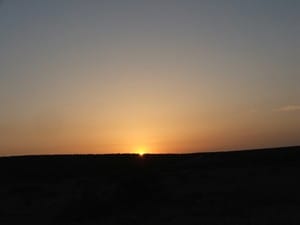 It’s a good idea to be across the Start/Finish line before 6:00 AM. It will be dark – a spotlight might help you find your gate. The gates are marked with yellow signs usually wired to the gates.
It’s a good idea to be across the Start/Finish line before 6:00 AM. It will be dark – a spotlight might help you find your gate. The gates are marked with yellow signs usually wired to the gates.
When you arrive at the spot, look it over before you set up camp. Consider any turns in the road, daylight visibility, and the direction the racers will be going on both the northbound and southbound runs.
If your station is very close to a curve, it is generally safer to be on the inside of that curve. If you are between right and left turns, as in an elongated “S”, you’ll have to look at other factors. Remember, the racers go South in the morning, North in the afternoon, and you don’t want to have to move during the break.
Consider the distance from the side of the road to the fence – some areas have a lot more room than others. Put vehicles and people as far from the road as practical. Park parallel to the road if possible, near the fence. Make yourself a smaller target. Watch out for thorns – flats are not fun.
You don’t have to be right on top of your gate, but make sure that you will be close enough to the gate to easily see and talk to anyone approaching them, before they can endanger themselves or racers. If there are unmanned gates nearby, keep an eye on them as well.
Set up your station to your own taste, with a few limitations:
STAY OFF THE ROAD.
Stay away from the road and shoulder when cars are running.
Set up some shade and a place to sit or stand.
Don’t have anything out that might be mistaken for a control flag. Don’t confuse the racers.
Be careful around the fences. They are private property, and some have barbs.
Look at the road around your gate. Remove any debris or road kill before the road is closed. Throw dead animals as far over the fence as possible – downwind and away from your position. Buzzards may be attracted, and they are very dangerous to racecars. Generally, leave the greenery alone, although I doubt anyone would be upset if you pulled some weeds or knocked down some tall grass to get a better camera shot. Don’t cross fences.
Once there is enough light and you’re pretty much set, do a trash sweep. Pick up any trash you find, yours or otherwise. It doesn’t take much effort, and it makes your view and photos better. Leave the area in better shape than when you found it. After the race, do another trash sweep to make sure you got it all and pack the trash out to a local dumpster. There are some in Rooney Park. Luckily, that’s where many of the racers and workers relax before cleaning up for the banquet.
A sweep car will come by, starting the route around 7:00 AM. Listen to the radio, and you should hear them doing radio checks at each gate. When they call you, answer to show that you’re there, awake, and able to operate the radio. The only other vehicles you should see after the sweep are clearly marked official vehicles or racers.
Put the grid sheet on a clipboard and secure the loose end with a large rubber band. Dealing with loose papers in the wind will not enhance your experience. You will be notified of any grid changes over the radio.
During The Race:
 Stay off the road.
Stay off the road.
Keep your eyes and ears open.
Listen to the race radio.
Keep track of the cars that pass.
Inform Race Control of safety problems.
Follow Race Control instructions.
The faster cars are hitting 200+ MPH on the long straights. That’s 3.5 miles per minute. Divide the distance from the starting line to your gate by 3.5 to get an idea how many minutes it takes the first unlimited car to get to you once the race starts. When you hear on the radio that the race has started, check your watch. Remember that there may have been a lag before the start notice got relayed to you.
After the first car, cars will begin to appear at about one minute intervals. The slower classes will be separated by less time. The further you are from the starting line, the more variation in interval – what the Army calls the “Slinky effect”. You may occasionally see cars traveling close together or even passing.
Cars may not come by you in the grid order, for several reasons. The grid may have changed right before the race. A car may not have started at all, or may have broken before it got to you. That’s a good reason to keep keep track of the cars as they pass by marking them on the roster.
Even if you don’t know cars well, at least notice the color and if possible the number. That should be more than enough to find the car on the grid sheet.
My Sequence:
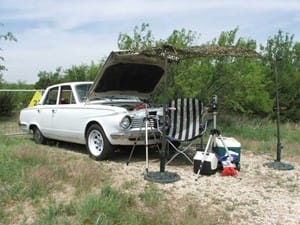 Hear or see a car coming
Hear or see a car coming
Turn cameras on
Track and snap photo
Identify the car
Mark on grid sheet
Cameras off
Look and listen for the next one.
There will be a break in the race between the southbound and northbound legs. In Sanderson, the racers will be regridding for the return run, and it takes a while. After the last car passes headed south, you can relax a bit, and have some lunch. This is when I check battery and memory card status on cameras, get the grid sheet ready for the next leg, move my shade and chair to face the south, and relax.
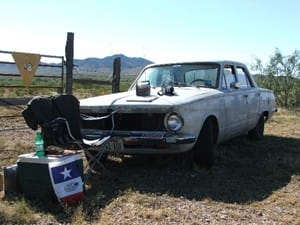 If you’re grilling, be VERY careful about fire safety. Closed grills are a very good idea, and may be required. Depending on conditions, there may be a fire ban in place – check before the race.
If you’re grilling, be VERY careful about fire safety. Closed grills are a very good idea, and may be required. Depending on conditions, there may be a fire ban in place – check before the race.
If you plan to have beer, please have a plan to get back to town safely and legally.
The second leg is run just like the first, and the same rules apply.
Emergencies and Problems:
Your shirt says “Course Official”, but you are not a referee, decision-maker, or enforcer. Your role as a gate guard or flag station is observation and communication. You are the eyes and ears of Race Control.
Medical Emergencies.
Call Race Control on the radio, and STAY OFF THE ROAD. EMT’s, firefighters, and law enforcement officers are stationed along the course and can get to any point quickly – probably quicker than you could drive to the hospital.
Accidents: If a car wrecks, call Race Control immediately with the location and as much information as you have. The most important thing at that point is to notify the first responders. They have to tools and training to handle most situations without endangering more people. Stay on the radio to make sure the message gets out and to provide more information.
Unauthorized vehicles on the road. If you see a vehicle that is not part of the race on the road during the event, try to wave them over. Politely explain the situation and that they should pull completely off the road. If they stay on the road, call Race Control with your location, a description of the vehicle, and their direction. “Race Control, This is Gate 15. A white pickup just passed me going North on the road, over.”
Dangerous road conditions (roadkill, gravel, oil spill, car parts, etc). Call Race Control with the location and description.
People near the road: If people approach your gate from inside the fences, you get to earn your T-shirt and goodie bag. Courtesy matters here. They may have just come down to watch the race, or to meet you. I’ve had a couple of good conversations that way. Keep on doing the job while you enjoy their company. But if they head to the gate and it looks like they’re going to get on the road, wave them over and explain that the road is closed until the race is over. Ask them to wait until the event is over at, say, 4 or 5 PM. If they insist and it still looks like they are going to get on the road, call Race Control immediately and give details. Ask the driver to wait. It may be necessary to let the driver talk to Race Control over the radio. Race Control may find a way to accommodate their needs or send an officer to handle things.
Race cars stopping for any reason. A racer may be forced to pull off the road near your gate with a broken car or other problem. He is then out of the race. Call Race Control with the car number and/or description, driver condition, road condition (debris/oil, etc), whether the car is on the road, on the shoulder, in a field, et cetera. “Race Control, this is Gate 15. Car XX has stopped at Gate 15. The driver is OK. The car is on the grass near the fence. The road is clear. Over.”
Any time you use the radio, give your location and the nature of the problem. Expect to get requests for more information, and to repeat what you’ve already reported. Race Control has to be certain. Press the button, speak slowly and clearly, then release the button and listen.
When NOT to use the radio:
- “Whooowhee! Did you see that?”
- “What was that car?”
- “I think I spilled my beer.”
- Chit chat, funny comments, or games on the radio can interfere with important transmissions that you can’t hear.
After the race: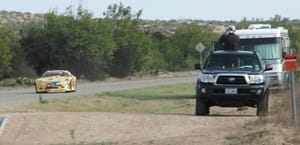
- Once the last vehicle on your grid list has passed heading North, you can start packing up. Stay off the road – there may be stragglers and there will be official vehicles moving around. DO NOT LEAVE. KEEP YOUR RADIO ON. Remember to get the sign, and have all of the issued equipment where it’s easy to offload.
- Do not pull out until Race Control releases you. After the last vehicle, there will be a sweep vehicle, race officials, and Sheriff’s department vehicles clearing the course. When they’re done, they will relay word to course workers that the road is open and that everyone is released.
- Then, if you’re ready, you can head into town. Drive safely and legally into town. The speed limits are in effect, and there are a lot of officers out there!
- There will be a drop off point for radios and signs somewhere between the start/finish line and town – look for a trailer and other course workers. Take your trash to a dumpster, grab a cold soda, and go hang out at Rooney Park with the racers. Take “After” pictures of bug-splattered race cars.
- Cool off, clean up, and get ready for the Awards Ceremony, if you’re going.
- When you get home, make sure you check the bulletin board on the website for the stories, photos, and videos that get posted.
- Be safe, have fun, and sign up for next year!
What to bring:
Minimum:
- Armband from the Courseworker meeting for every one in your group, already on the wrists.
- “Course Official” T-shirt on the person in charge of the gate, at least.
- Two-way radio and whatever else was issued at the meeting.
- A car for shade and music.
- Drinking water
- Lunch
- Pencils
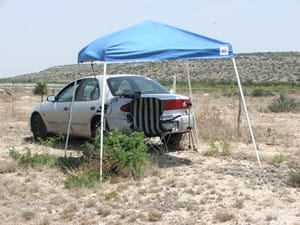 What else I bring (Yes, it all fits in a compact car):
What else I bring (Yes, it all fits in a compact car):
- Everything in the goodie bag It’s all there for a reason. Even the bag itself.
- Cooler w/ ice, water, soda It gets hot out there!
- Light jacket It’s cool before dawn!
- Flashlight It’s dark before dawn!
- Sunblock It’s bright after dawn!
- Hat(s) I use a straw hat for midday, or a ball cap if the wind kicks up.
- Clipboard For the grid sheets.
- Large rubber bands To keep the grid sheets on the clipboard
- Pencils To check off the cars as they go by / get scratched / etc.
- Shade An 8’X8’ pop-up canopy, the biggest I can easily set up by myself.
- Stakes for shade The wind can toss a canopy.
- Hammer Helps drive stakes for the flag station marker panel and the shade
- Chair Something comfortable, with a cup holder.
- Extended power plug Lets me put the 25W radio anywhere I want it.
- Small folding table A place to set the clipboard, etc.
- Trash bags For any trash I find in the area that won’t fit in the goodie bag
- Work gloves In case I have to move something nasty off the road
- Binoculars. Why not look around while you’re waiting? It’s pretty country.
- Cameras There will be lots of Kodak moments.
- Toilet Paper
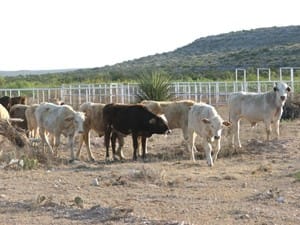
Bring whatever you need for the day.